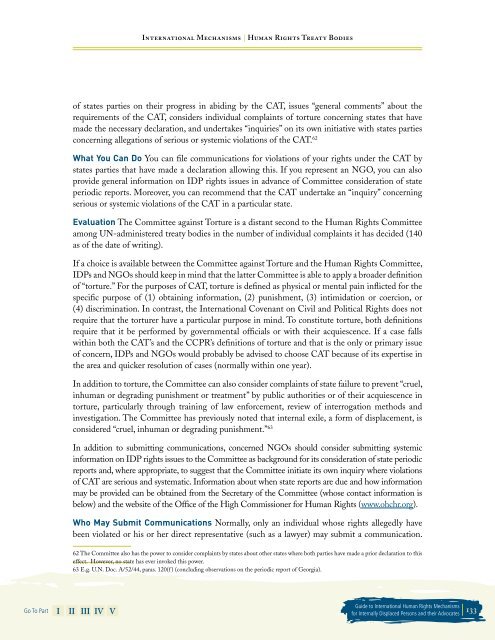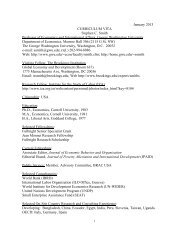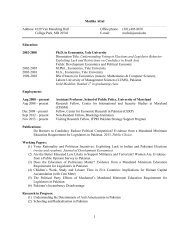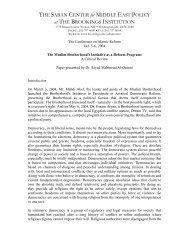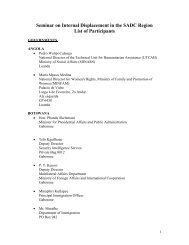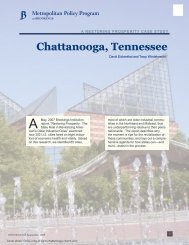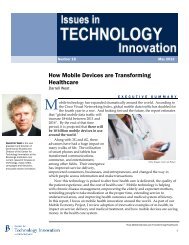Guide to International Human Rights Mechanisms - Brookings
Guide to International Human Rights Mechanisms - Brookings
Guide to International Human Rights Mechanisms - Brookings
You also want an ePaper? Increase the reach of your titles
YUMPU automatically turns print PDFs into web optimized ePapers that Google loves.
Go To Part I II III IV V<br />
<strong>International</strong> <strong>Mechanisms</strong> | <strong>Human</strong> <strong>Rights</strong> Treaty Bodies<br />
of states parties on their progress in abiding by the CAT, issues “general comments” about the<br />
requirements of the CAT, considers individual complaints of <strong>to</strong>rture concerning states that have<br />
made the necessary declaration, and undertakes “inquiries” on its own initiative with states parties<br />
concerning allegations of serious or systemic violations of the CAT. 62<br />
What you can Do You can file communications for violations of your rights under the CAT by<br />
states parties that have made a declaration allowing this. If you represent an NGO, you can also<br />
provide general information on IDP rights issues in advance of Committee consideration of state<br />
periodic reports. Moreover, you can recommend that the CAT undertake an “inquiry” concerning<br />
serious or systemic violations of the CAT in a particular state.<br />
evaluation The Committee against Torture is a distant second <strong>to</strong> the <strong>Human</strong> <strong>Rights</strong> Committee<br />
among UN-administered treaty bodies in the number of individual complaints it has decided (140<br />
as of the date of writing).<br />
If a choice is available between the Committee against Torture and the <strong>Human</strong> <strong>Rights</strong> Committee,<br />
IDPs and NGOs should keep in mind that the latter Committee is able <strong>to</strong> apply a broader definition<br />
of “<strong>to</strong>rture.” For the purposes of CAT, <strong>to</strong>rture is defined as physical or mental pain inflicted for the<br />
specific purpose of (1) obtaining information, (2) punishment, (3) intimidation or coercion, or<br />
(4) discrimination. In contrast, the <strong>International</strong> Covenant on Civil and Political <strong>Rights</strong> does not<br />
require that the <strong>to</strong>rturer have a particular purpose in mind. To constitute <strong>to</strong>rture, both definitions<br />
require that it be performed by governmental officials or with their acquiescence. If a case falls<br />
within both the CAT’s and the CCPR’s definitions of <strong>to</strong>rture and that is the only or primary issue<br />
of concern, IDPs and NGOs would probably be advised <strong>to</strong> choose CAT because of its expertise in<br />
the area and quicker resolution of cases (normally within one year).<br />
In addition <strong>to</strong> <strong>to</strong>rture, the Committee can also consider complaints of state failure <strong>to</strong> prevent “cruel,<br />
inhuman or degrading punishment or treatment” by public authorities or of their acquiescence in<br />
<strong>to</strong>rture, particularly through training of law enforcement, review of interrogation methods and<br />
investigation. The Committee has previously noted that internal exile, a form of displacement, is<br />
considered “cruel, inhuman or degrading punishment.” 63<br />
In addition <strong>to</strong> submitting communications, concerned NGOs should consider submitting systemic<br />
information on IDP rights issues <strong>to</strong> the Committee as background for its consideration of state periodic<br />
reports and, where appropriate, <strong>to</strong> suggest that the Committee initiate its own inquiry where violations<br />
of CAT are serious and systematic. Information about when state reports are due and how information<br />
may be provided can be obtained from the Secretary of the Committee (whose contact information is<br />
below) and the website of the Office of the High Commissioner for <strong>Human</strong> <strong>Rights</strong> (www.ohchr.org).<br />
Who may submit communications Normally, only an individual whose rights allegedly have<br />
been violated or his or her direct representative (such as a lawyer) may submit a communication.<br />
62 The Committee also has the power <strong>to</strong> consider complaints by states about other states where both parties have made a prior declaration <strong>to</strong> this<br />
effect. However, no state has ever invoked this power.<br />
63 E.g. U.N. Doc. A/52/44, paras. 120(f ) (concluding observations on the periodic report of Georgia).<br />
<strong>Guide</strong> <strong>to</strong> <strong>International</strong> <strong>Human</strong> <strong>Rights</strong> <strong>Mechanisms</strong><br />
for Internally Displaced Persons and their Advocates 1


